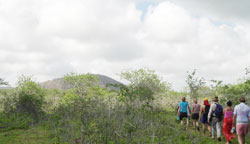Galapagos project brings students close to ecosystem

Concordia Biology students partake in a tour on the island of San Cristobal, where they explored the natural habitat and breeding site of the legendary Galapagos tortoises.
Photo by lawrence tsang
Many people know the Galapagos as the backdrop for Charles Darwin’s seminal theory on evolution. Seven Concordia Biology students recently got a first-hand look at the environmental crises facing his fabled archipelago.
“It was like having a museum right in front of our eyes. There are species there that don’t exist anywhere else in the world,” said Lawrence Tsang, president of the Biology Students Association (BSA) and founder of the Concordia Galapagos Project.
Tsang and fellow students Clemence Larroche, Viktor Germanov, Richard Saba, David Leroux-Petersen, Wendy MacKerricher and Chad Thompson spent nearly three weeks in the Ecuadorian isles last month.
They partnered with the Jatun Sacha Foundation, an NGO with its own private reserve on the island of San Cristobal. Among other things, they helped develop sustainable farming techniques for the indigenous population and construct improved living quarters and laboratories for future visitors to the reserve.
Larroche noted the significance of the islands, long one of planet’s greatest biology labs. “It’s the only place on earth where 95 per cent of its original species are still intact.”
“But the problem with the Galapagos is that they’re so isolated, so most of the species there aren’t used to competition: This makes them very vulnerable,” Tsang said.
The islands are heavily dependent upon the Ecuadorian mainland for food and other goods. However, shipments often carry stowaways like seeds or animals. “Every day, a new species is introduced onto the islands which disrupts their delicate ecosystems.”
This is why it’s important for the indigenous population on the islands to try to become as self-sufficient as possible in such an ecologically sensitive area, he added.
The students’ main task was to battle the aggressive Mora berry. Introduced to the islands 15 years ago by a woman who unwittingly brought seeds there from the mainland, the tough, thorny plant has since become a scourge.
“They’re everywhere on the islands and compete with native species,” Tsang said. The students cut through the woody stems with machetes and pulled the plants out by their roots. “And for every root that you miss, four new plants spring up from it,” Larroche said.
For this inaugural visit, Tsang received funding from the Concordia Student Union, the Arts and Science Federation of Associations and the university administration. Participants also engaged in other fundraising activities.
Tsang graduates this year, but is producing a report to help next year’s BSA executive continue the project.
